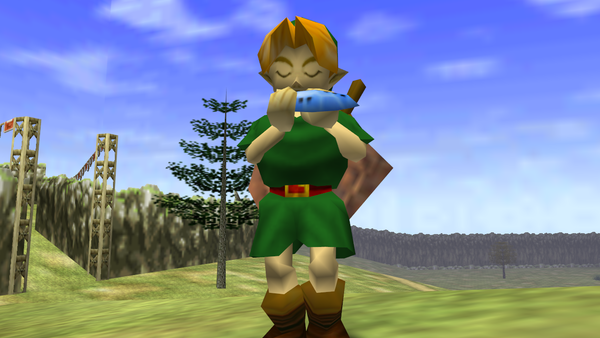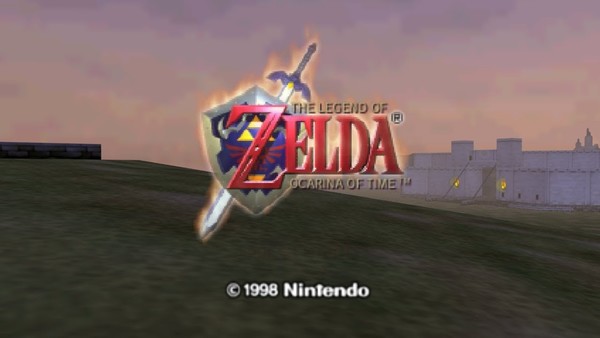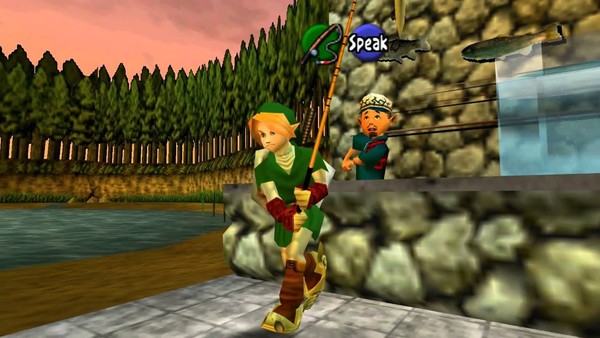Remembering The Legend Of Zelda: Ocarina Of Time - 20 Years Later
Ocarina of Timeless - often imitated, but never replicated.

Twenty years ago on this day, a sullen-faced sales clerk regretfully informed me that, despite being surrounded by dozens and dozens of copies of the game, the just-released Legend of Zelda: Ocarina of Time was entirely sold out. And what's worse, he didn't expect his branch - or any in the locality - to receive any more copies before Christmas.
I was utterly crestfallen. In December 1998, Ocarina of Time wasn't just top of my Christmas list, it was my Christmas list. My dad tried his best to console me. "Never mind, son," he said, with one arm on my stooped shoulders. "We'll be able to get it next year."
So you can only imagine my unbridled ecstasy when, come Christmas morning, one final, suspiciously square-shaped present was unearthed right beneath the tree - with me as its addressee. I tore the paper off without even pausing to think. The store assistant, clearly going above and beyond his duties, had been roped into an act of parental subterfuge: in my hands, was Ocarina of Time.
It was all I could do to suppress my excitement just long enough to get through Christmas dinner and the usual festive formalities before I was allowed upstairs to jump headfirst into Hyrule. After reverentially placing the cartridge in my Nintendo 64, I tremulously flicked the power switch. And then something strange happened:
I started to cry.
Besides some fury-inspired sobbing after yet another failed attempt to see Alex Kidd in Miracle World through to the end, no video game had ever had this effect on me. But it wasn't just the occasion getting the better of my emotions. No opening sequence had ever been so evocative, either before - or arguably, since.

An elegant Nintendo splash screen gives way to a setting moon, as the sympathetic colours of daybreak creep across a sparse but hauntingly beautiful landscape. The sound of distant hoofbeats are met by a serene piano melody (as it happens, a variation on Super Mario 3's warp whistle tune), before we see our hero, dashing across the plains - in every respect - atop his trusty steed. The title logo gracefully fades into the centre of the screen, and it's only after some moments that we're given the prompt to 'Press Start' that we're reminded: this is a game.
I - and my nose - were completely blown away. It was unlike pretty much every other opening sequence I'd ever encountered - usually some developer credits followed by a wall of text plastered atop a digitised mock-up of the box art. The menu which followed put us back on familiar ground, the usual array of invitingly empty save slots overlaid by an update on Link to the Past's fairy fountain theme, but within the space of half a minute, Ocarina of Time had already proved it was something special. My heart was hooked - and it'd remain so for the next two decades.
Those opening moments weren't just an excessively stylish smokescreen for a game lacking fundamental substance. If Mario 64 had offered the industry the technical blueprint for 3D games, Ocarina of Time provided the artist's masterclass. Nintendo's first landmark invented the brush; Zelda's leap into the third dimension painted the Sistine Chapel.

So entrenched in the firmament of video games' vocabulary have Ocarina of Time's many innovations became that it's easy to forget a time before them. 3D gaming was steadily finding its feet towards the end of 1998, but many developers were still tripping over their shoelaces. Nintendo's masterpiece took an enormous stride. It solved the persistent problem of combat in an added third-dimension in one go, thanks to the elegant 'Z-targeting' system. Pretty much every third-person action game which followed, from Soul Reaver to Grand Theft Auto adopted a variation of Ocarina's lock-on mechanic. A context-sensitive action button introduced a new layer of dynamic complexity necessary for a game of such scope, doing away with the needlessly cumbersome specific controls which had previously proved unwieldy in this new 3D paradigm. Again, it soon became the de facto standard. It's also to thank - or blame - for oh-so-many fishing minigames - few of them better.
But the magic of Ocarina of Time wasn't in its mechanics; this wasn't a supremely impressive but ultimately shallow technical demo in the vein of SEGA's equally ambitious Shenmue two years later. Shigeru Miyamoto and his team were able to flesh out their framework with a truly captivating world, replete with both charm and challenge. The devilish dungeon design of Link to the Past was not just transplanted, but upgraded for Link's first 3D outing, the added dimension utilised as a blessing rather than a hindrance. Every new item rewarded players as they explored the new possibilities; rarely had the development team not second guessed their experimentation. Aside from lamenting flute manufacturers, the eponymous ocarina wasn't just totally fresh outside of LOOM, but strangely intimate. Even the 'Z-targeting' system was explained with a narrative contrivance in the form of nagging fairy Navi. This world wasn't just impressively big. It was impressively alive.

This was no better demonstrated by its central hub, Hyrule Field. By the day's standards, it was gargantuan, but unlike the open-world games of twenty years later, it had a sense of both place and purpose. It's almost become cliché, but the one thing people most fondly remember about Ocarina of Time is stepping out of Kokiri Forest for the first time. The realisation that Death Mountain, looming ominously in the background during the journey to Hyrule Town, could be visited, was as exhilarating as it was emancipating. It's no coincidence that it wasn't until Nintendo's Breath of the Wild that players experienced anything close to the same sensation.
Every Christmas Eve, I have a personal tradition of trying to play through Ocarina of Time in a single sitting (it's a good job I don't have kids to worry about - though this revelation might explain why). As the years have passed, the industry's imitation and subsequent refinement has made elements of the game's execution feel passé, even outdated. But I soon find myself completely besotted once again, reminded why I fell in love that first Christmas morning. The magic of Miyamoto's masterpiece has never faded - and it's unlikely to ever be replicated.